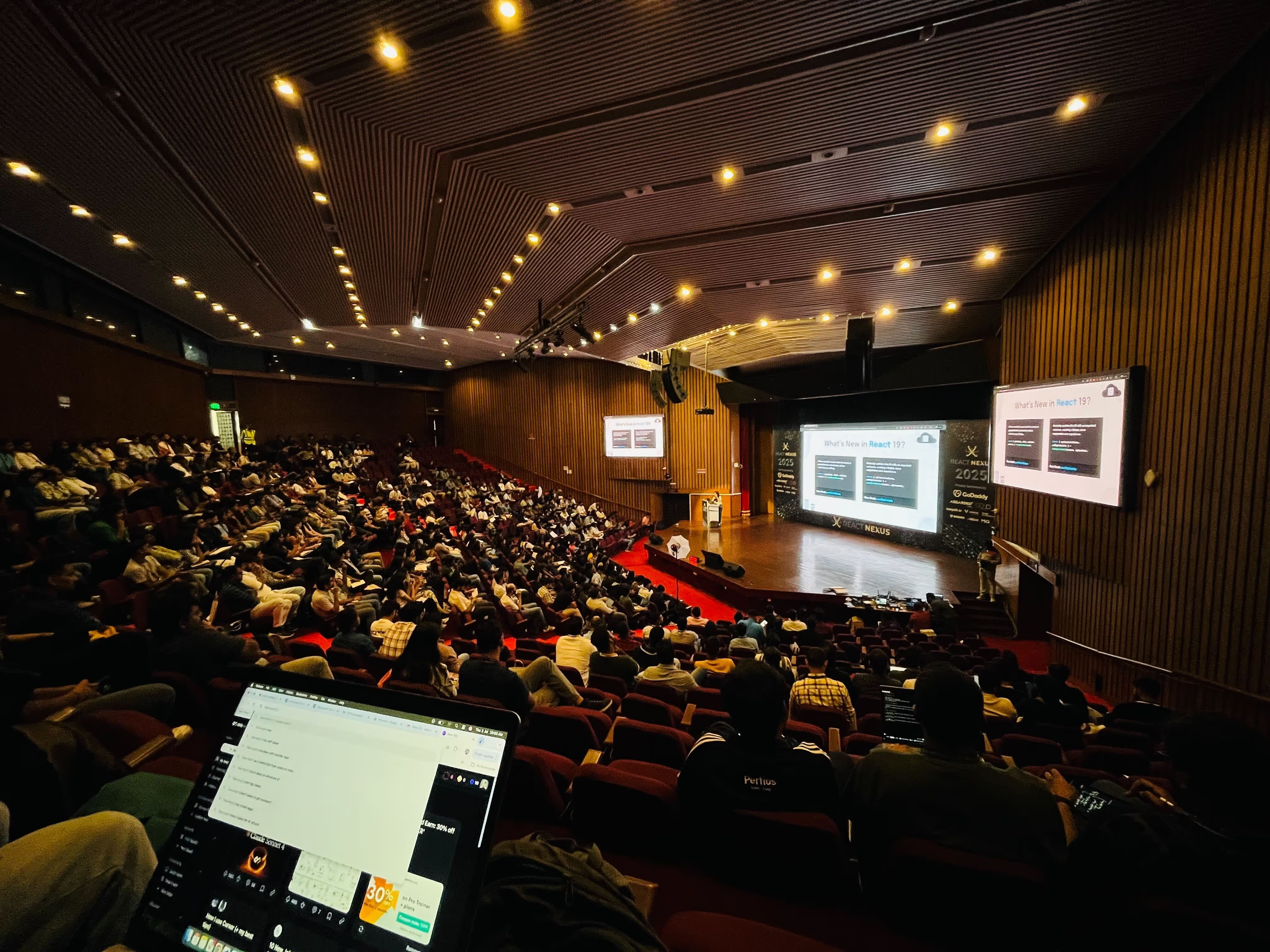Are we moving towards a future where we write less code or where we write code more intelligently?
At this year's React Nexus, held at IISc Bengaluru, felt like a bit of both. The sessions and conversations portrayed that React 19 and AI are transforming our development processes, and the way we build software is evolving fast.
By automating repetitive tasks and minimising boilerplate code, these tools allow us to concentrate on what really matters, creating performance-driven architectures, enabling inclusive user experiences, and building systems that endure over time.
For the 700 attendees, this was more than just another tech event. With 29 brilliantly sharp speakers sharing their insights, it became a space to really pause and think about where React is going, and where our whole industry might be headed.
Personally? It was unforgettable. My first-ever tech conference, and oddly enough, it didn’t feel like a formal event at all. It felt more like a reunion.
For the past 3 years, I’ve been working remotely at QED42, bonding with my team through Slack threads, Google Meet calls, and GitHub pull requests. Getting to meet my teammates from the Pune office again was something else entirely.
Day 1: performance, architecture, and understanding the core
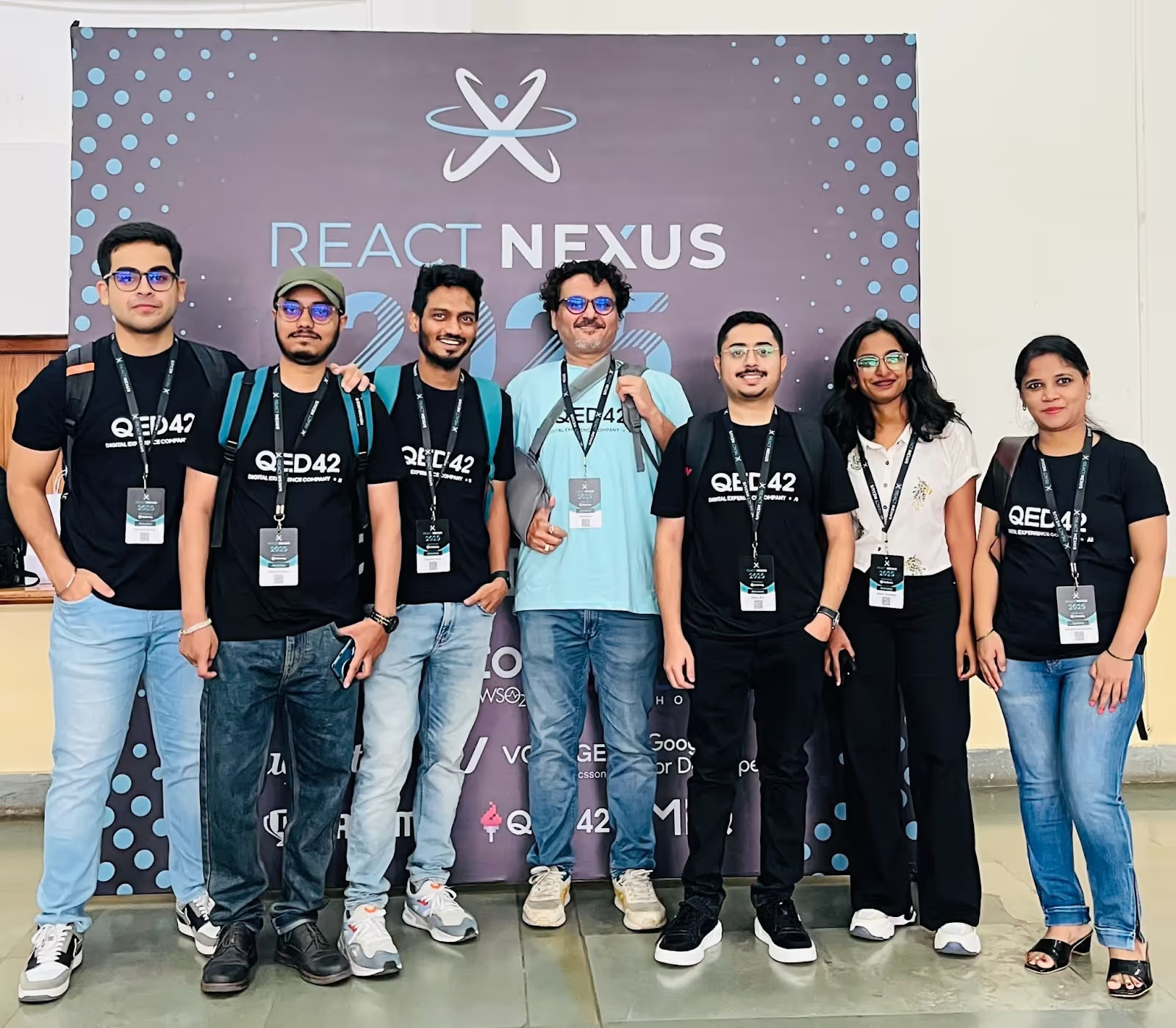
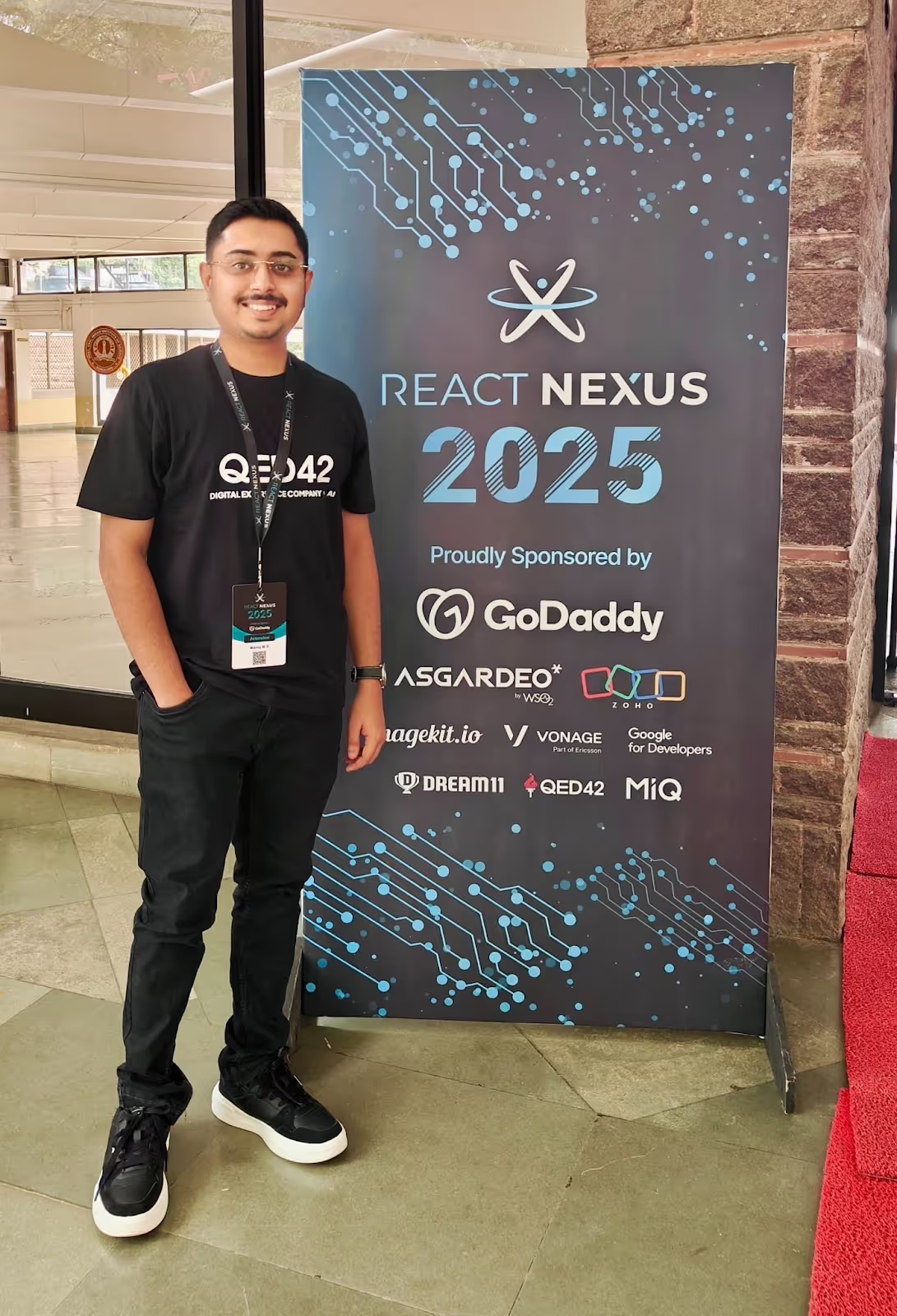
The first day was an incredible opportunity to understand fundamentals that scale. From exploring the React Compiler to understanding Fiber internals, each session was packed with insights you could immediately apply to real-world problems..
The event was run really well. Registration was quick, volunteers were on point, and everything just flowed smoothly.
The breaks for tea and lunch weren’t just a breather; they gave us a perfect chance to network with fellow developers and check out booths from companies like ImageKit, Asgardio, GoDaddy, Vonage, and Zoho Catalyst.
React 19: from boilerplate to beautiful
In her session on building better forms with React 19, Nipuni Paaris demonstrated how React 19 is transforming our approach to forms. With the introduction of new form actions and hooks, the era of tedious form boilerplate may finally be behind us. It's a relief for developers, seamlessly integrated into the framework.
Akash Hamirwasia shared what it’s like to adopt the new React Compiler. If performance tuning has ever taken over your workflow, this will feel like a breath of fresh air. The compiler now takes care of optimisations like memoisation, letting you stay focused on writing clear, expressive code.
Wadad Parker’s session on context was informative and full of personality. While prop drilling can feel like a workout, React 19’s revamped Context API streamlines state sharing, making it more efficient and reliable, with fewer unnecessary re-renders.
Scaling systems: from micro frontends to micro-architecture
Padam Jeet Singh and Shruti Bansal from GoDaddy shared practical strategies for making micro frontends work at scale. Their session focused on building shared infrastructure, setting up strong communication between teams, and putting solid governance in place. With the right structure, micro frontends become a reliable way to grow large applications without losing control.
Alok Kumar Singh from Cashfree Payments gave a clear and thoughtful breakdown of React Fiber internals. He explained how React handles rendering through incremental, interruptible updates and how lane-based prioritisation helps manage what gets rendered and when. It offered a deeper look at the mechanics behind React’s responsiveness and performance.
Performance & observability: build fast, stay fast
Harshit Budhraja from ImageKit.io delivered a session full of practical tips for improving Lighthouse scores, especially for media-heavy applications. He walked through techniques like using responsive images and AI-powered transformations through ImageKit.io. The live demo showed how these optimisations can make a real difference in both speed and quality.
Apurv Khare from Adobe explored the difference between knowing something broke and understanding why it happened. His session on frontend observability covered how to use sampling-based telemetry, real-time profiling, and structured logs to gain deeper insights. The focus was on moving from reactive fixes to proactive improvements that keep systems healthy and predictable.
Supercharging your IDE: the AI coding sidekick
I tested every cursor trick, so you don’t have to!
In her session, Tanisha Sabherwal talked about how the cursor isn’t just an editor; it’s your coding companion, demonstrating how to leverage context-aware prompts and other cursor features to receive AI support that truly understands your project's structure.
Give your code editor real superpowers
In this lightning talk with Apoorv Taneja was incredibly engaging, highlighting how MCPs can transform your editor with amazing new capabilities.
After a full day of learning, we navigated the infamous Bengaluru traffic to enjoy a wonderful team dinner, energised by the ideas we had discussed throughout the day.
Day 2: The rise of the AI-native developer
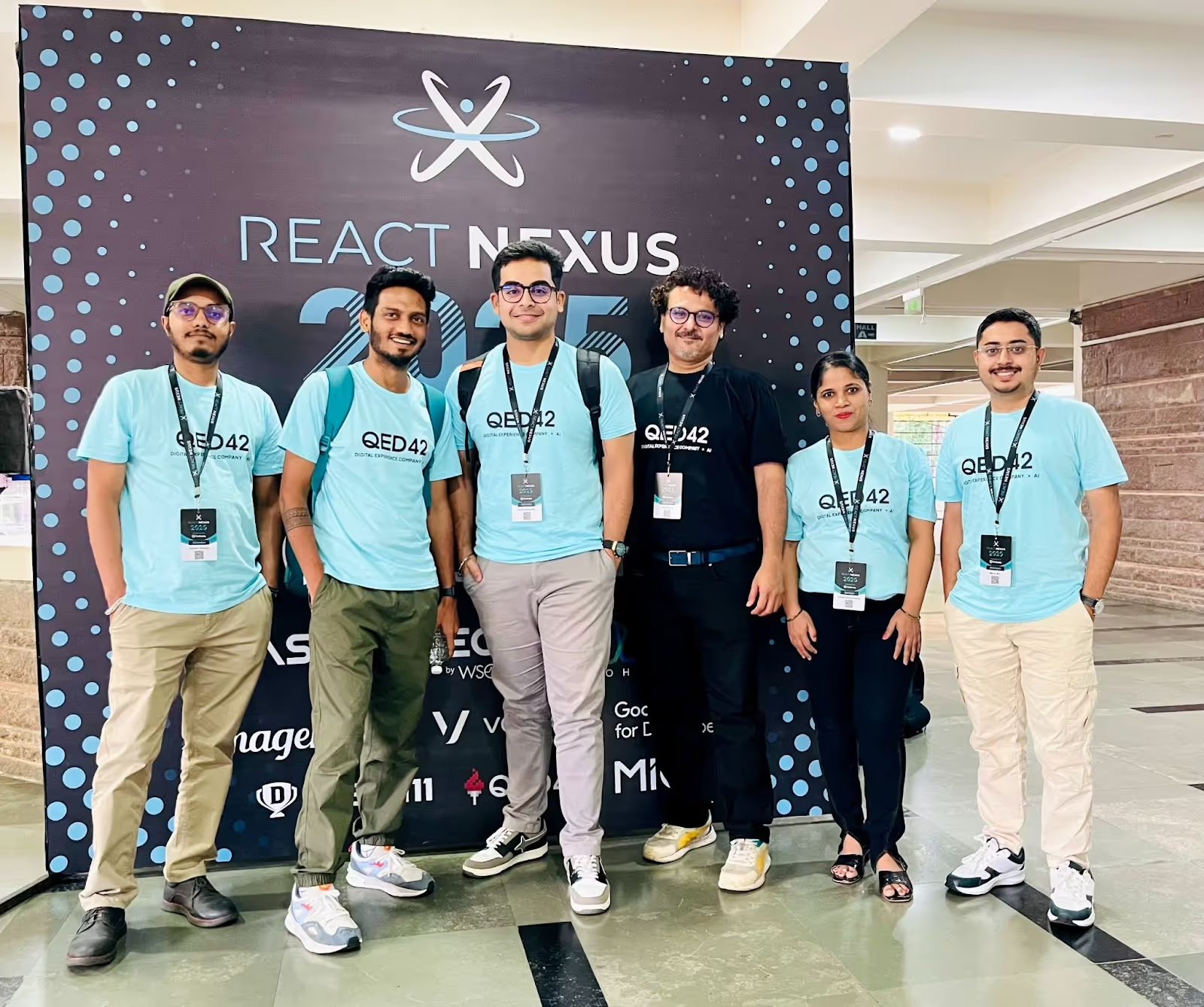
While Day 1 laid the groundwork, Day 2 propelled us into a future where AI is seamlessly integrated into development processes.
AI as co-pilot: from design to code
Chaitanya Deorukhkar from Razorpay showed how their design system, Blaze, works with an MCP server to generate React components directly from Figma. This setup brings design and development much closer, turning design files into production-ready code almost instantly.
Sanket Sahu from GeekyAnts walked us through the evolution of visual builders and introduced ShaperStudio, a new tool designed to connect design environments like Figma with developer tools like VS Code. It’s built to make collaboration between designers and developers smoother and more intuitive. We were so impressed, we caught up with him after the session and managed to get early access to try it out ourselves.
Accessibility as default, not an afterthought
Building accessible UI with copilot – Navya Agarwal
Showed how Copilot can be an accessibility partner if you ask the right way. Copilot can help us address accessibility issues. Concluding with a powerful quote: “Accessibility isn't more work, the work was incomplete.”
Input accessibility deep dive with Shrilakshmi Shastry emphasised the importance of using proper ARIA labels and understanding when and how to apply them. She warned that incorrect use of ARIA can do more harm than good, stating, “No ARIA is better than bad ARIA.” Through clear examples, she demonstrated the proper application of these attributes.
These sessions fundamentally changed how I think about Accessibility and our ethical responsibilities as front-end developers.
A proud moment: framework mastery in action
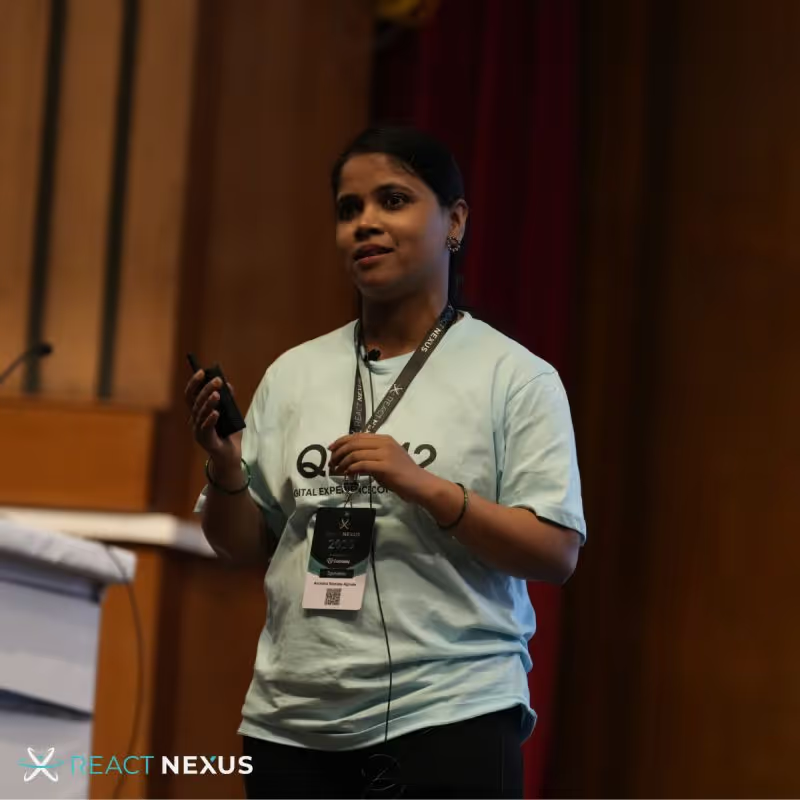
The highlight of Day 2, and perhaps the entire conference for my team, was a moment of immense pride watching our colleague, Archana Agivale, Tech Lead at QED42, take the stage. Her talk, "Static Regeneration: Supercharging Next.js with Strapi Webhooks," was a masterclass in solving a real-world problem we all face.
She presented an elegant strategy for keeping static sites fresh without constant rebuilds by batching updates from Strapi via webhooks and using Next.js's Incremental Static Regeneration (ISR).
The result? Static sites with dynamic superpowers blazingly fast, always up-to-date, and incredibly efficient. It was a brilliant showcase of practical innovation, and seeing her share that expertise with the wider community was a fantastic experience.
Panel discussion on AI was the cherry on top
It was captivating to listen to developers from Razorpay and Adobe discuss how AI is transforming our coding practices. The panel shared honest takes on both the potential and pitfalls of AI. While tools like Cursor, Copilot, and ChatGPT can enhance our productivity, they also require careful oversight and guidelines.
The day rounded out with more framework mastery from Tapas Adhikary on Next.js caching and Soumya Ranjan Mohanty on using Web Workers for smoother UIs, before Akshay Kumar U gave a demonstration of running a language model entirely on the client-side using React and WebLLM, paving the way for innovative, private AI features that operate directly on devices.
Key takeaways
As I look back on my first-ever tech conference, a few core ideas stand out:
- The Developer's role Is Shifting to architecture. With React 19's built-in Compiler now taking care of optimisations and AI assistants generating boilerplate code, our main contribution is shifting higher up the stack. We are transitioning into architects who design scalable, high-performance systems.
- Performance is not a Feature, it's the foundation. From React Fiber internals to image optimisation and frontend observability, the message was clear: building fast and resilient applications is an essential part of our role.
- Accessibility is a moral imperative. The back-to-back sessions on accessibility served as a strong call to action. It's not merely a "nice-to-have" or an afterthought; it's our fundamental duty to create an inclusive web experience for everyone.
- AI is becoming a core layer of the UI. The future isn't just about using AI to write code; it's about building intelligence directly into the user interface itself. On-device WebLLMs are just the beginning of this new frontier.
More than just a conference
As Day 2 came to a close, so did one of the most memorable experiences of my career so far.
After the final session, our team met for dinner before my colleagues returned to Pune. It was the perfect pause to reflect on everything we had learned, discussed, and experienced over the past two days. The energy, the ideas, and the people all came together in a way that felt both inspiring and grounded.
React Nexus 2025 wasn’t just a showcase of what’s possible with React 19 and AI. It was a celebration of how far we’ve come and a glimpse into where we’re heading. More importantly, it was a reminder that the community sits at the heart of everything we do. Behind every new feature or tool is a group of people asking thoughtful questions, sharing what they’ve learned, and helping each other grow.
While i had met them before, this was the first time i truly got to spend meaningful time with them. After three years of remote collaboration, sitting around the same table and sharing stories felt incredibly meaningful.
As we wrapped up and said our goodbyes, I left feeling more connected, more curious, and more excited about what we get to build next.
